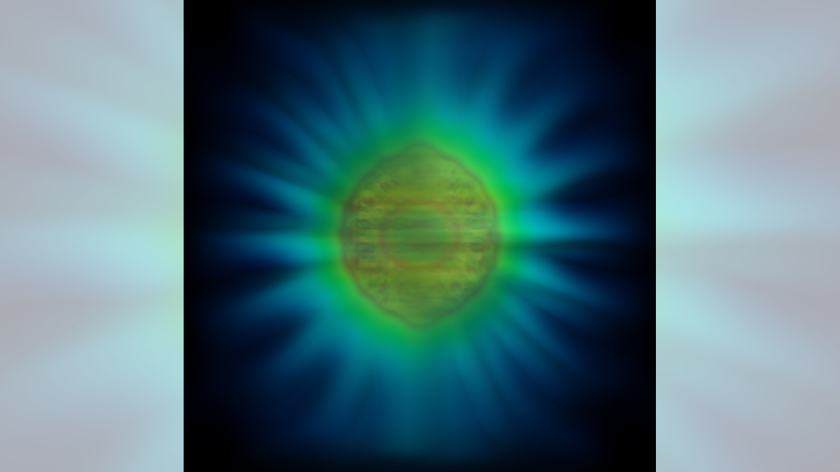Liquid Droplets Reveal Clues To Quantum Behavior

(ISNS) -- After a droplet falls onto a vat of vibrating liquid, what it does next could help solve fundamental mysteries in quantum physics. Now, scientists have mapped out the behavior of such drops to more detail than ever before, discovering new ways in which they can move.
If a vat of fluid throbs with too little force, the droplet falling onto it will merely disappear into the liquid. With just the right amount of force, however, the drop will bounce in place or even walk across the surface of the fluid. It can also behave even more unusually. Depending on how the liquid is shaken, it might regularly switch the sizes of its jumps, or zigzag about in unpredictable ways.
Increasingly, scientists find the way these walking droplets behave uncannily mimics strange effects previously only seen on a microscopic level in the quantum realm, where objects can apparently exist in two or more places at the same time or spin in two opposite directions simultaneously.
For instance, quantum physics has famously found that particles that one might expect to act like billiard balls can behave like the waves one might see rippling across a pond. If a wave traveling on the surface of water encounters a barrier with two slits, it is possible for two waves to emerge on the other side, creating a series of ripples known as an interference pattern. Electrons and other quantum particles striking a screen with two holes in it will generate similar interference patterns, essentially behaving like both a particle and a wave on different parts of its journey.
It turns out the waves a droplet generates as it bounces off holes in barriers submerged in a vat of vibrating fluid recreates similar patterns of waves. "In some sense it behaves like a particle, in some sense like a wave," said researcher John Bush, an applied mathematician and fluid mechanician at the Massachusetts Institute of Technology.
The way these drops behave corresponds to a long-neglected attempt to explain the wave-like behavior of quantum particles. In the early days of quantum physics, French physicist Louis de Broglie suggested quantum particles are borne along on guiding waves of some type, like a buoy on a tide. Since no physical example was discovered for this so-called pilot wave theory, it was for the most part abandoned — these bouncing droplets and vibrating fluids, discovered in 2005 by French physicist Yves Couder, mark the first real example of pilot-wave theory since it was proposed more than 80 years ago, Bush said.
These recent findings could revive the question of whether there is a secret foundation to quantum physics. Pilot-wave systems are chaotic, just like weather systems — they are sensitive to disturbances in a way that can make them behave in a probabilistic manner, just like quantum particles.
Sign up for the Live Science daily newsletter now
Get the world’s most fascinating discoveries delivered straight to your inbox.
"If pilot-wave systems can reproduce the mysteries of quantum mechanics with dynamics that you can observe, there's a possibility that they could provide clues as to how dynamics might work on the quantum scale," Bush said.
Now Bush and his colleagues have conducted the most detailed analysis yet of how droplets bounce and walk on quivering fluids. They also unexpectedly discovered an exotic new kind of walking drop, ones with a mixed gait, alternating the speeds at which they bounced up and down.
The scientists explored how droplets of a range of sizes and viscosities—their level of resistance to flow – behaved on fluid vibrated at a variety of frequencies. The experimental setup involved a circular tray filled with silicone oil jostled up and down by an industrial shaker. Drops 400 microns to 1,000 microns wide — about four to 10 times the average width of a human hair — were created by rapidly dipping a needle into the fluid, and high-speed cameras helped gauge the width of droplets and capture their behavior.
"The experiments are extremely delicate, sensitive to external vibration," Bush said. "We were fearful of the effects of the passing subway."
It remains uncertain what insights the researchers' discovery might yield, though the results are strengthening theoretical models Bush and his colleagues have developed to describe the behavior of these drops. Their efforts may improve the chances of discovering liquid analogs to the quantum realm, Bush said. The findings of their recent research are detailed in a trio of papers appearing in August, two in the Journal of Fluid Mechanics and the third in the journal Physics of Fluids.
"We now have a whole new approach to the problem of describing the quantum world," said theoretical physicist Antony Valentini at Clemson University in South Carolina, who did not take part in this study.
"These analog models will surely suggest new theoretical ideas, as well as inspiring us to rethink de Broglie's original ideas from the 1920s. The models are also likely to suggest new ways in which quantum mechanics might break down, as well as suggesting how quantum theory might be modified."
Inside Science News Service is supported by the American Institute of Physics. Charles Q. Choi is a freelance science writer based in New York City who has written for The New York Times, Scientific American, Wired, Science, Nature, and many other news outlets.












